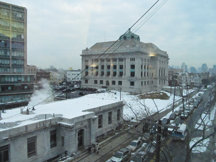County Republicans and Democrats are so far apart on how to redistrict county freeholder districts that the matter may eventually be settled in court.
Republican and Democratic chairmen are supposed to name two members from each party to a committee to redraw the district lines, based on information obtained from the 2010 Census.
In the form of county government that was established in Hudson County in 1974, the population is divided into nine districts. Each one is overseen by a Hudson County freeholder, who sits on the Board of Chosen Freeholders, which oversees regulations and contracts regarding county facilities. These districts are adjusted after every federal census.
“I want the seats to go back to the people.” – Jose Arango
________
Democrats are hoping to keep the districts largely the same as they are now – somehow accounting for the massive growth in Hoboken over the last 10 years.
“That’s the big concern,” said Steve Gallo, spokesperson for Bayonne Mayor Mark Smith – who as chairman of the HCDO – is scheduled to pick two Democrats to begin redrawing the freeholder legislative maps.
Republicans have already picked their people and have already started laying out maps that are starkly different from the existing freeholder districts.
Jose Arango, chairman of the Hudson County Republican Party, said he envisioned a whole revision of the districts based on ethnic makeup, rather than geographical ones.
Both Democrats and Republicans admit that Hoboken’s increase in population will change that part of the map, regardless of which party gets the final say.
“The biggest question is Hoboken,” Gallo admitted. “We have to somehow create a balanced district, although we do not see great changes elsewhere, just a block here or there. Hoboken will present a challenge because of its spike in numbers.”
The population of Hoboken grew from 38,577 residents in 2000 to 50,005 in 2010.
District boundaries matter for reelection
Redistricting can be a nightmare for incumbents, altering the population so significantly that it removes their traditional voting base. Areas of a district can differ sharply from one another depending upon numerous factors, any of which can alter the way people vote, such as rates of employment or unemployment, level of wealth or poverty, home ownership or renting, needs for social services, levels of education, crime rates, age, and race and ethnicity of residents.
Freeholders – who are all required to run every three years – are facing re-election this year, which means the new district lines will be critical in determining who is eligible to run and how a candidate will conduct his or her campaign.
Although Hudson County is considered friendly territory for Democrats – with a consistent level of registered Democrats at about 125,000 over that last four years – the county has become less overwhelmingly Democratic than in the past, with nearly 130,000 registered voters claiming no party and almost 30,000 registering as Republican.
Despite the overwhelming majority of Democrats, the laws for redistricting do not favor one party over the other.
“In this we have as much power as the Democrats,” Arango said, and his aim is to use this power to break up the political lock party bosses have over freeholder seats. “I want the seats to go back to the people.”
A radical change in Republican maps
So the Republican maps for the new districts will look sharply different from those the Democrats will propose, Arango said.
Democrats are seeking to stick close to the existing map, which gives Bayonne its own seat; three full seats in Jersey City; another seat which is all of Hoboken and a slice of Jersey City; a seat that represents West New York, Weehawken, and Guttenberg; a seat that represents Union City; a seat for all of North Bergen and a portion of Secaucus; and then another seat that has most of Secaucus, all of Kearny, Harrison, and East Newark.
Democrats will likely recommend changing the configuration of the Hoboken seat, slicing away the portion that is in Jersey City heights and expanding the Hoboken seat along the waterfront into downtown Jersey City.
Arango said he is proposing districts that will cross city lines, but reflects the ethnic and racial makeup of the area. So in his map, Bayonne would be divided between two freeholder districts.
“This will get Mayor Smith angry, but the Hispanic and African American populations in Bayonne will be better served if they are put into a district with parts of Jersey City that have strong Hispanic and Latino populations.”
This is also true of the west side of Jersey City, which Arango proposed should be part of a district that includes Harrison, East Newark, and Kearny. In his map, Secaucus would be brought into one district again, but instead of being connected to North Bergen, the Republican map would makeup a district of the Jersey City Heights and Secaucus, possibly giving the freeholders an Indian representative. His map would find similar ethnic and racial boundaries in North Hudson, although it is possible that his map could shape a waterfront district to reflect the populations that are currently living along the waterfront in Guttenberg, Weehawken, Hoboken, and Jersey City.
“I don’t care if (Freeholder Bill) O’Dea has to ask (Freeholder Al) Ciffelli for a seat because they are both in the same district in June,” Arango said. “This isn’t about protecting anybody’s seat, it is about having freeholder districts, and the freeholders who represent them, reflect the makeup of the people who live there.”
Al Sullivan may be reached at asullivan@hudsonreporter.com.
